Igor Gomes’ career has been on an upward trajectory since 2020 when he began regularly starting for São Paulo. Then, at 21 years of age, Igor was already known from the youth categories of his team and the national team, as several fans and people around the world of football had recognized similarities between his game and the legendary, Kaká.
Since his retirement from football, the Brazil National Team hasn’t found that more-centrally based ‘10’ who turns as an ‘8’ and can be a ‘6’ too if he goes that deep thanks to his capacity in small spaces and passing ability.
However, his career has developed strangely. He has found a rhythm and regular form, but São Paulo sometimes look to other players rather than him. Teams like Real Madrid, Barcelona or Sevilla began watching the Brazilian when he first started to put in brilliant performances in the Brasileirão, but other teams like Nottingham Forest or Fulham have recently been linked with him, per some reports.
Igor is a versatile, technical and dynamic player when he’s on the ball. He has the right potential and talent to go abroad if he keeps playing the role he suits best. Over the past two seasons, São Paulo have been trying to use Gomes as an all-rounder part of the squad, deploying him in different roles and positions that definitely don’t fit him. This includes stints at positions such as right-winger, left-winger, centre-forward and even as a wide player in the 4-4-2 shape — something a bit Renato Sanches-esque at Lille, specifically in the season they won Ligue 1.
The role and position which fits Gomes the best is central, as a midfielder on a double-pivot where he can exchange his height between the lines, or as a pure ‘10’, looking to do damage behind the rival midfield line and find teammates with his through-passes.
In this tactical analysis and scout report, we’re going to assess Igor Gomes’ weaknesses, skills, and strengths while providing an in-depth analysis of which role and position he has to play constantly to keep developing his game. We aim to analyse how he has fit into São Paulo’s tactics best.
Wide-midfielder and the all-rounder role
As mentioned before, Igor Gomes progressed through São Paulo’s youth system as a more central player who also likes to appear in the half-spaces when playing in a double-pivot or as a ‘10’. If the 23-year-old has the freedom to run and receive on the pitch, he’s going to support massively his team in possession because of the positions between the lines he likes to take up and how he accelerates possessions with little details on and off the ball.
Igor has, at least since the start of 2021, been an all-rounder for his team. He normally covers the right-wing playing as an outside-midfielder in a 4-4-2 shape or to support in wide zones to free his full-backs to play in a more inside role. This isn’t something Gomes does badly, but being that positional and that wide on the wing makes him a bit inactive during phases of the game and doesn’t support his team as much as he would like to. When he plays more centrally, he also goes outside to drag defenders or to create confusion for his rivals.
Igor Gomes’ touch map in a game he played as a wide player through the right vs his touch map from a match where he played in a midfield-two through the right side of the pitch shows exactly which zones Igor likes to be in every third: the half-spaces.
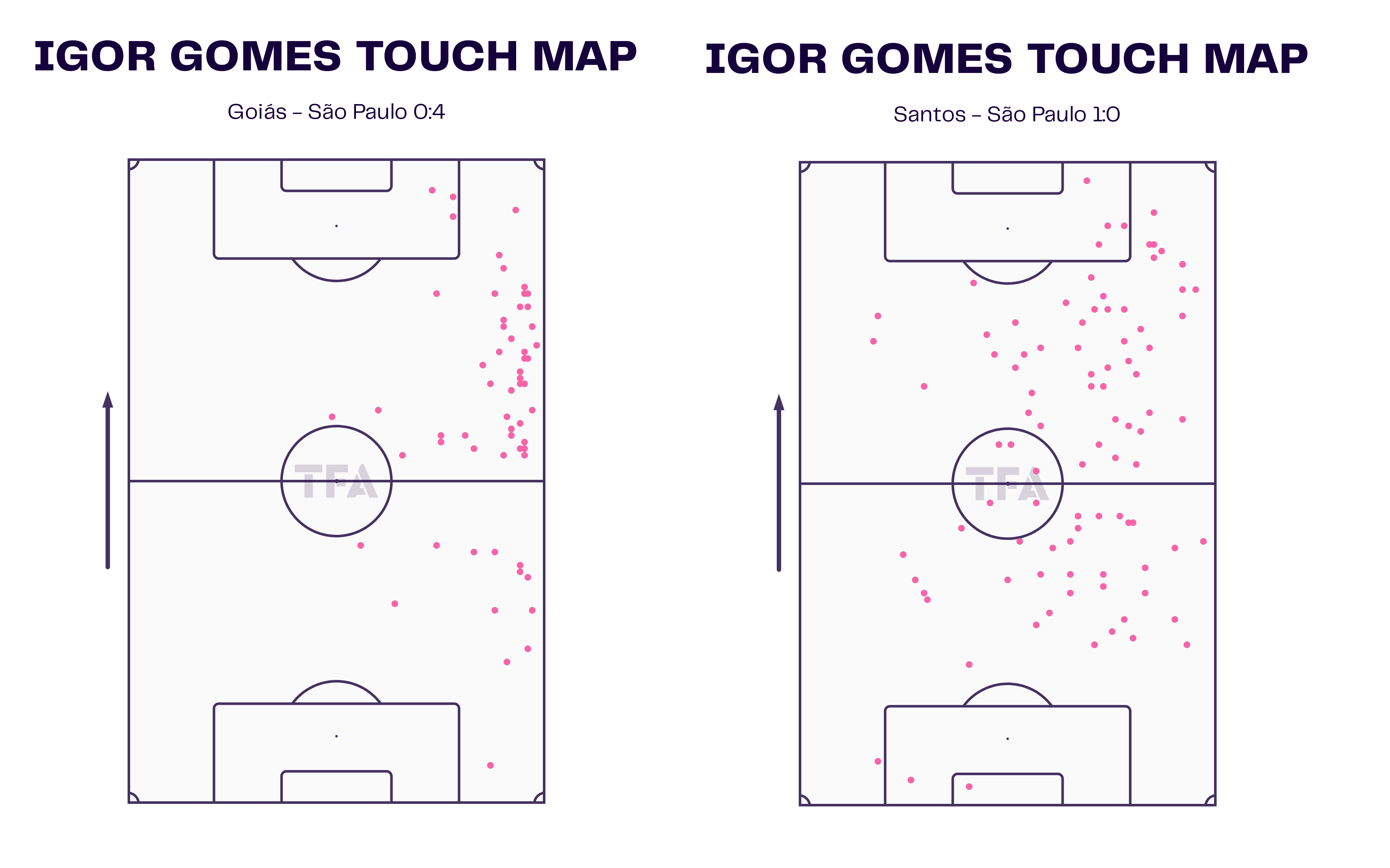
This has some explanation: São Paulo likes to oxygenate build-ups with passes to the wide areas, where a player like Gomes, with his vision and technical level, could beat the press and make his team run with space. Nevertheless, this doesn’t happen every time, so sometimes, we can see the Brazilian making backward passes or non-progressive passes because he’s in a zone where he can’t generate his full technical and tactical ability. Also, he has a very decent crossing ability, so keeping him out wide can be decisive in his performances.
Igor Gomes’ outside positioning has been a frequent sight inside São Paulo’s system when he has been the starter, as he has lost his spot in the starting lineup lately. As we can see against Goiás in his most recent game, he stands very wide, leaving all the central zones.
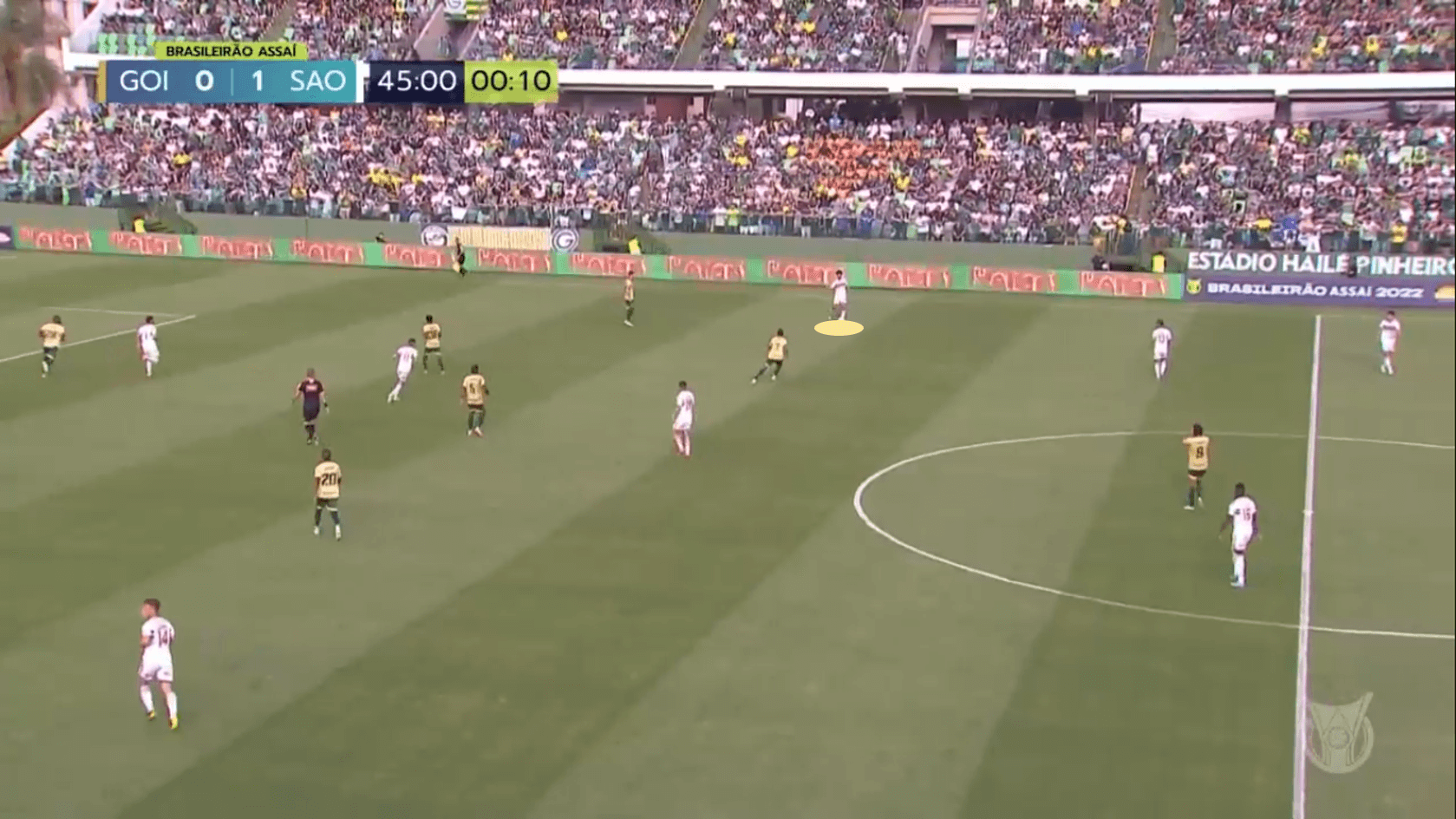
São Paulo also looks to deploy a technically-gifted player like Gomes outside to create this kind of situation: They overload the midfield and go out wide with Gomes who has excellent vision and executions, as the rival midfield is pinned, he looks to play behind the defensive-line, as one of the forwards makes the run.
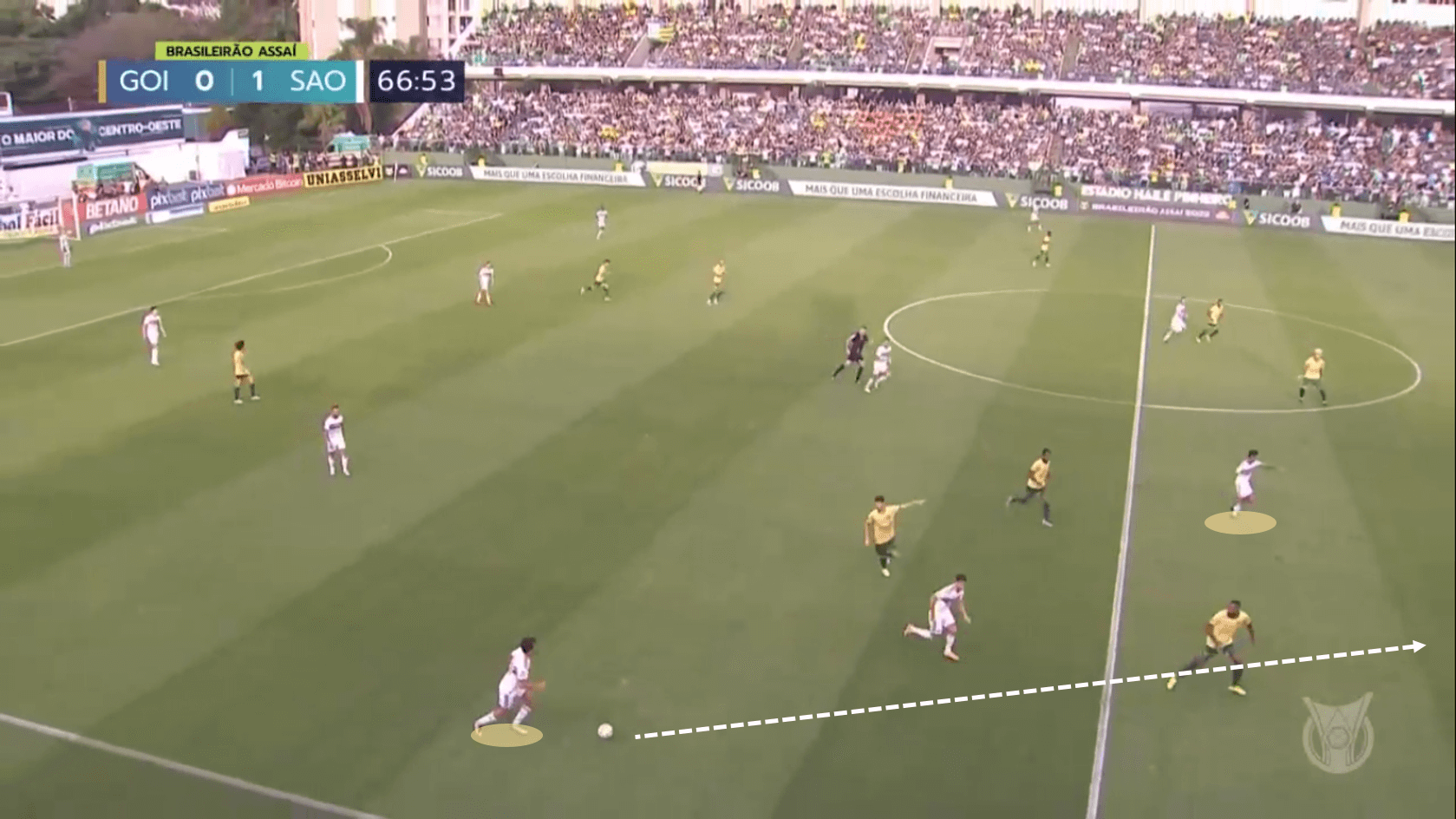
As we can see, Igor Gomes looks to get closer to the edge of the box in the wide areas, not getting that deep to the last line of the pitch. But he has shown a great crossing ability in his matches playing this wide. When starting in this rigid role without freedom of movement, his input comes in this way in the final third.
Against Goiás, he assisted the 0-1 for São Paulo. He received outside, drove through the edge of the box and played this brilliantly curved cross to the middle of the box where a teammate scored a lovely headed goal.

Undoubtedly, Igor Gomes doesn’t look that comfortable when playing on the wing. It can isolate him from being constantly involved on the ball between the lines. However, on the other hand, it works out tactically for Rogério Ceni, as his technique allows him to release awesome passes to a teammate making the run behind. The Brazilian likes to turn under pressure and play with a full vision of the pitch ahead of him, rather than with his back to goal.
Playing centrally as a ‘10’
Moving into this section of the analysis, Igor Gomes likes to place himself through the right-hand side of the pitch, frequently drifting into the half-spaces here. The 23-year-old has a great understanding of at which height he must be and also incredible skills to evade the pressure thanks to his dynamic game style. However, he has different roles and movements between every third of the pitch.
When starting or restarting the build-up, he likes to be present in the first passes of São Paulo’s possessions. Gomes likes to be energetic in his hunt to receive the ball, as he likes to be between the lines but also dropping off his line to receive in front of the mid-block and watch the pitch at full strength. In his own third, Igor looks to receive and carry from one side to another, to turn the rival block and look to rotate his team’s possession.
The picture below shows precisely Gomes’ positioning in São Paulo’s first stages of build-up. He drops from his line and scans 4 or 5 times before receiving the ball and after, looking for the best option to pass the ball to.
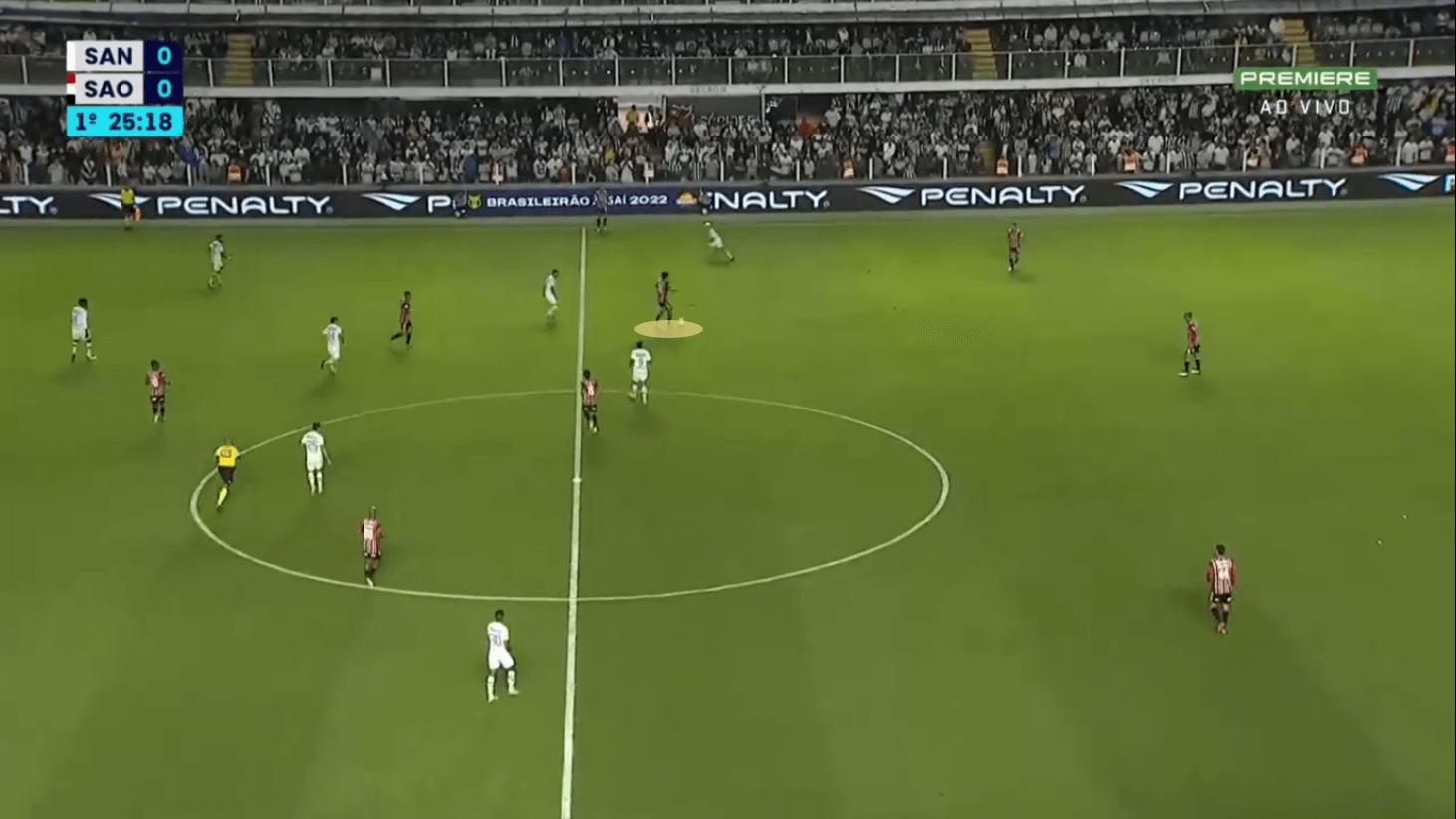
Igor Gomes is also a key player through the lines thanks to his passing technique and thinking speed. This is, of course, thanks to his scanning, as before getting in contact with the ball, the 23-year-old has already decided where the next pass is going. Normally, passes from centre-backs are played to Gomes who finds full-backs or wingers who drop back to help their team breathe a bit against high-pressing systems.
Progressive actions like this happen quite often when he’s playing through the middle, as São Paulo looks to pin midfielders to overload the central areas and, then, exploit the wide ones. Igor Gomes is a fantastic player to either realise first-time passes on the half-turn or control the ball, giving it one or two touches before then releasing a progressive pass that is going to make his team advance at least to the middle third.
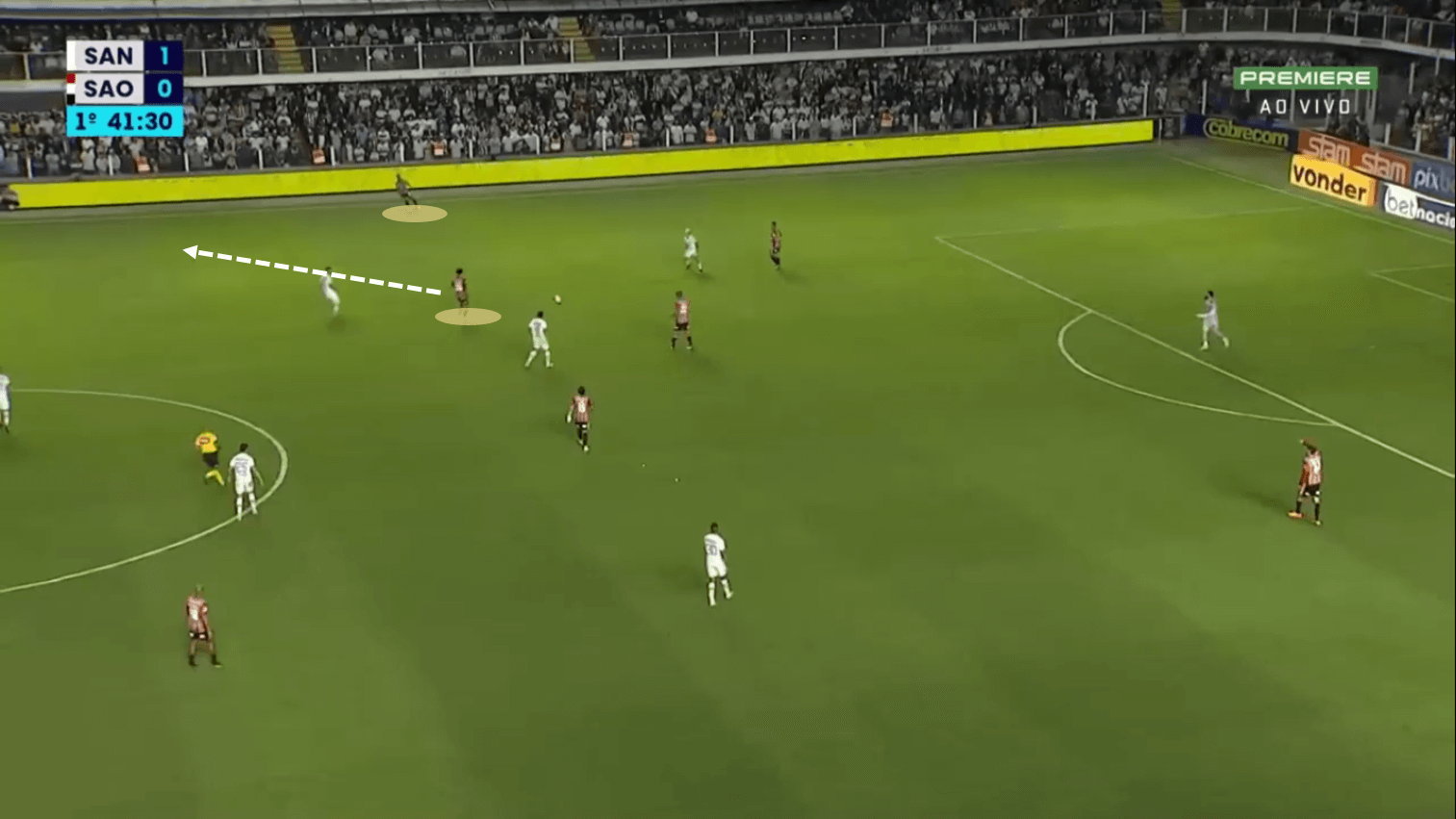
One-two situations and progressive carries are also important elements of Gomes’ playing style. The Brazilian likes to play with his full-backs to create wide overloads, then receive with space through the half-spaces and drive the ball forward. He has excellent ball control and high-level decision-making at high speeds.
Diagonal balls are also part of Igor Gomes’ game. He likes to take them from one wing to the other, but he also uses this tool when playing with time and space through the middle. If he has time to think about a solution against deep blocks, these diagonal balls are going to be a constant option in Gomes’ toolbox. Normally, he doesn’t like to make these passes during the initial build-up, so he wants to wait a bit more and advance some meters to execute them, as he could link up with threatening players in dangerous zones close to the rival box.
Against Santos in the picture below, Igor Gomes showed this feature of his game. He appeared with the ball through the central area and scans the passing options available. As he doesn’t spot an enticing passing option nearby, he decides to find a far teammate with a long ball taken brilliantly to the player’s feet who then generates a 1v1 duel.
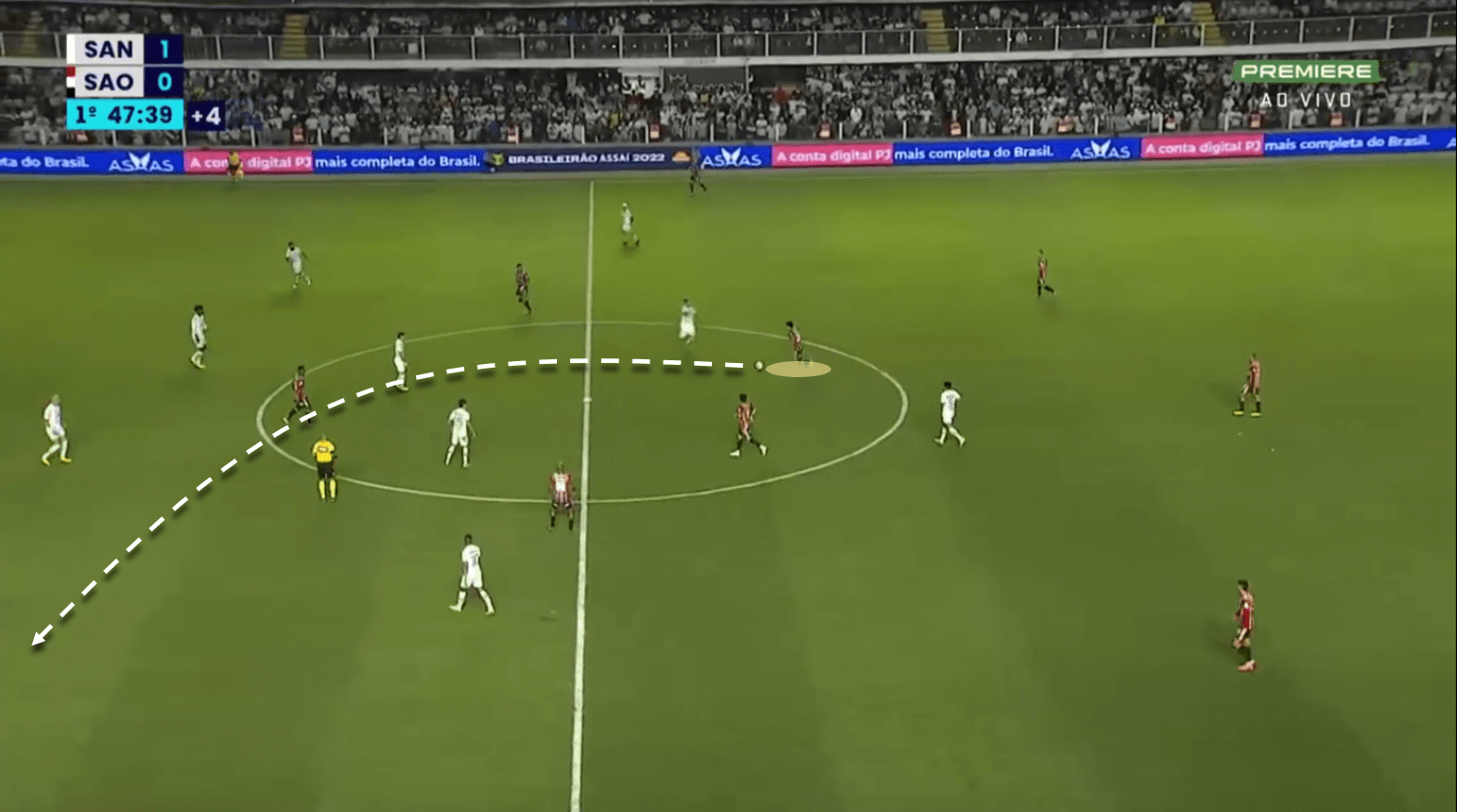
In the final third, Igor Gomes shows why he has been able to play as a wide midfielder. He likes to surprise defensive lines by swapping channels and positions, running from in to out where he can add some fine details like back heels or allow the ball to slip through his legs to confuse markers.
In this situation, he received the ball on the halfway line, and the inside winger tracked back to support him and break the pressure, he finds him well and they exchange heights and spaces. The winger goes centrally and Igor runs outside, he’s then the target once again in the attacking third but feints, majestically letting the ball go through his legs, then overlaps behind the full-back.

Igor Gomes likes to play at the edge of the box when playing as a midfielder. He doesn’t penetrate the box that much, as he’s a more possession-oriented player who likes to help his team in terms of how they progress on the pitch. In the final third, Gomes looks to find forwards who try to make out-to-in runs attacking the penalty area. He has a very large repertoire of passes that he shows off constantly. Some of them, including the outside-of-the-foot pass, he even makes with his first touch of the ball on occasion.
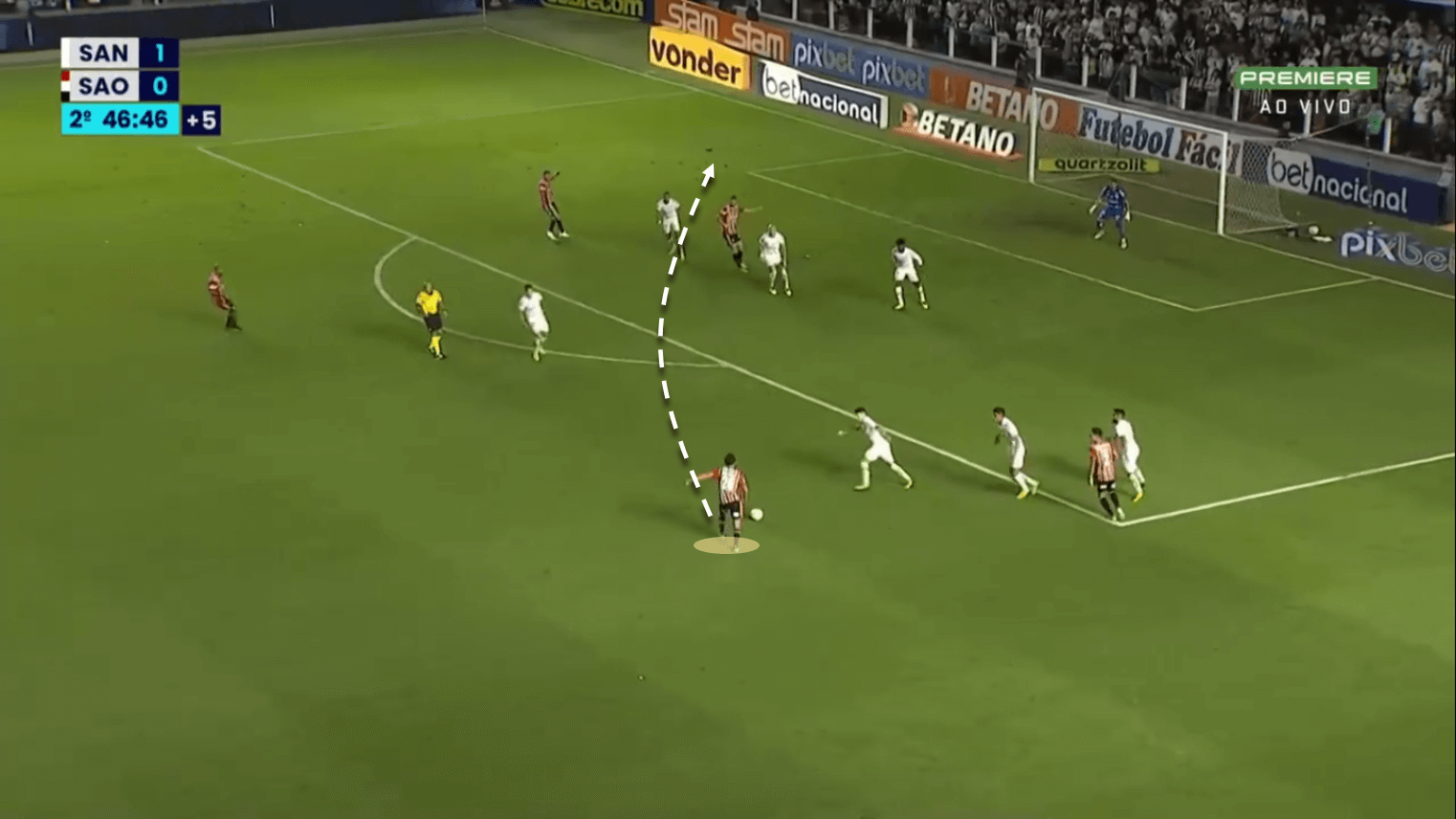
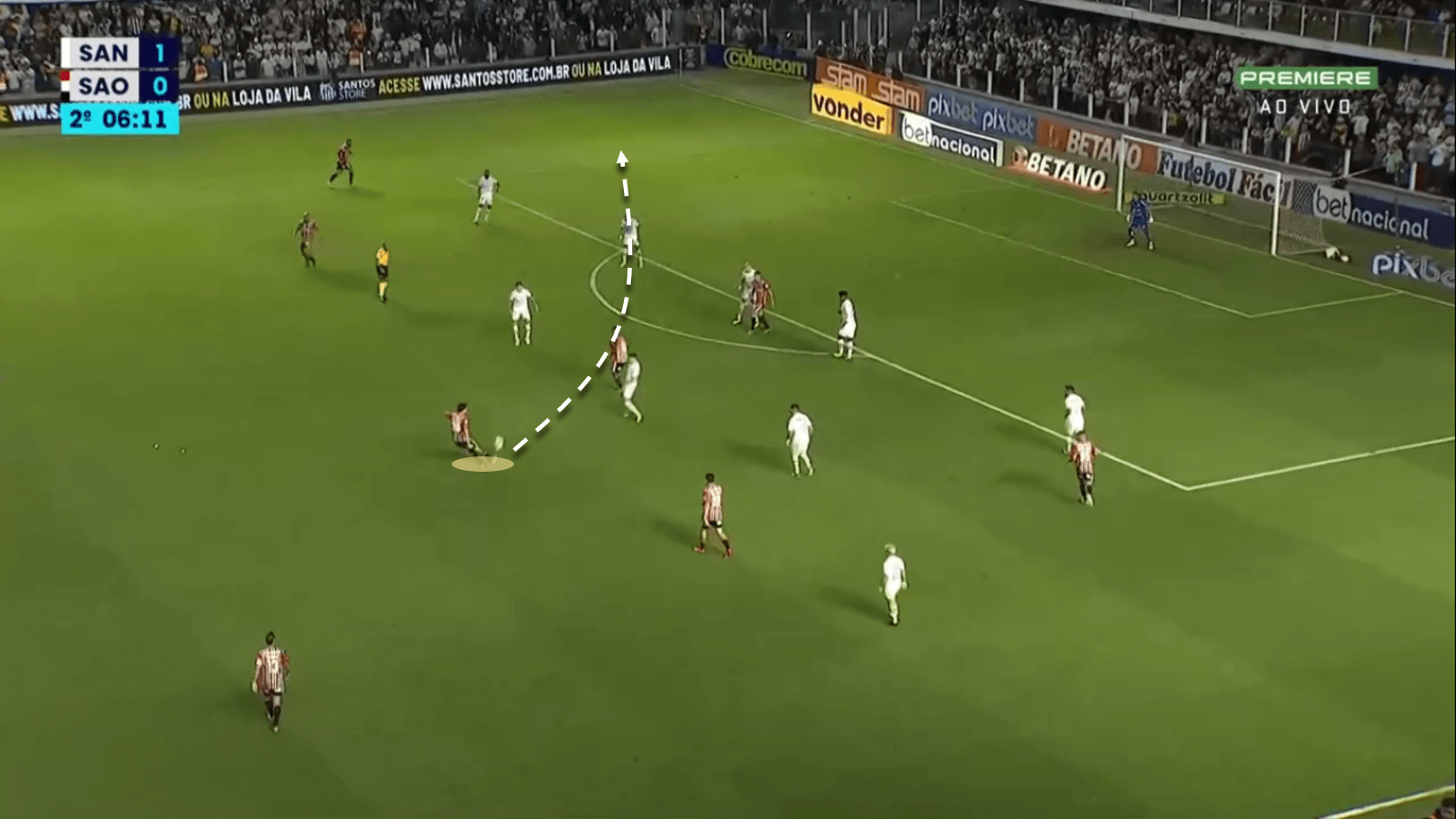
Conclusion
Igor Gomes is a player who helps his team in every phase of the game — the initial, the medium and the final one. He’s very active when playing through the middle, mostly as a director of attacks, transitions and possessions. He changes the orientation of the ball when needed and also makes through passes from deep when his team needs to be more direct.
Gomes is the polar opposite of a distributor who doesn’t accelerate that much during the build-up, as his dynamic movements and elastic hips make him a vital player to escape high pressure and small spaces. As well as that, he can help his teammates to find a solution when marked, thanks to his off-the-ball supporting runs.
He has to keep playing through the middle, stepping into the half-spaces and oxygenating build-up, while still getting involved high up the pitch where he can be decisive with pre-assists or even shoot sometimes, as he’s not that much of a prolific goalscorer.
At 23 years of age, Gomes has developed massively inside São Paulo, growing through their academy to being one of the key players of the squad. His game would definitely fit into Europe — mostly leagues such as Serie A or Bundesliga where this type of player who slowly accelerates the tempo of the game in little seconds is very much appreciated for his ability and tactical smarts.

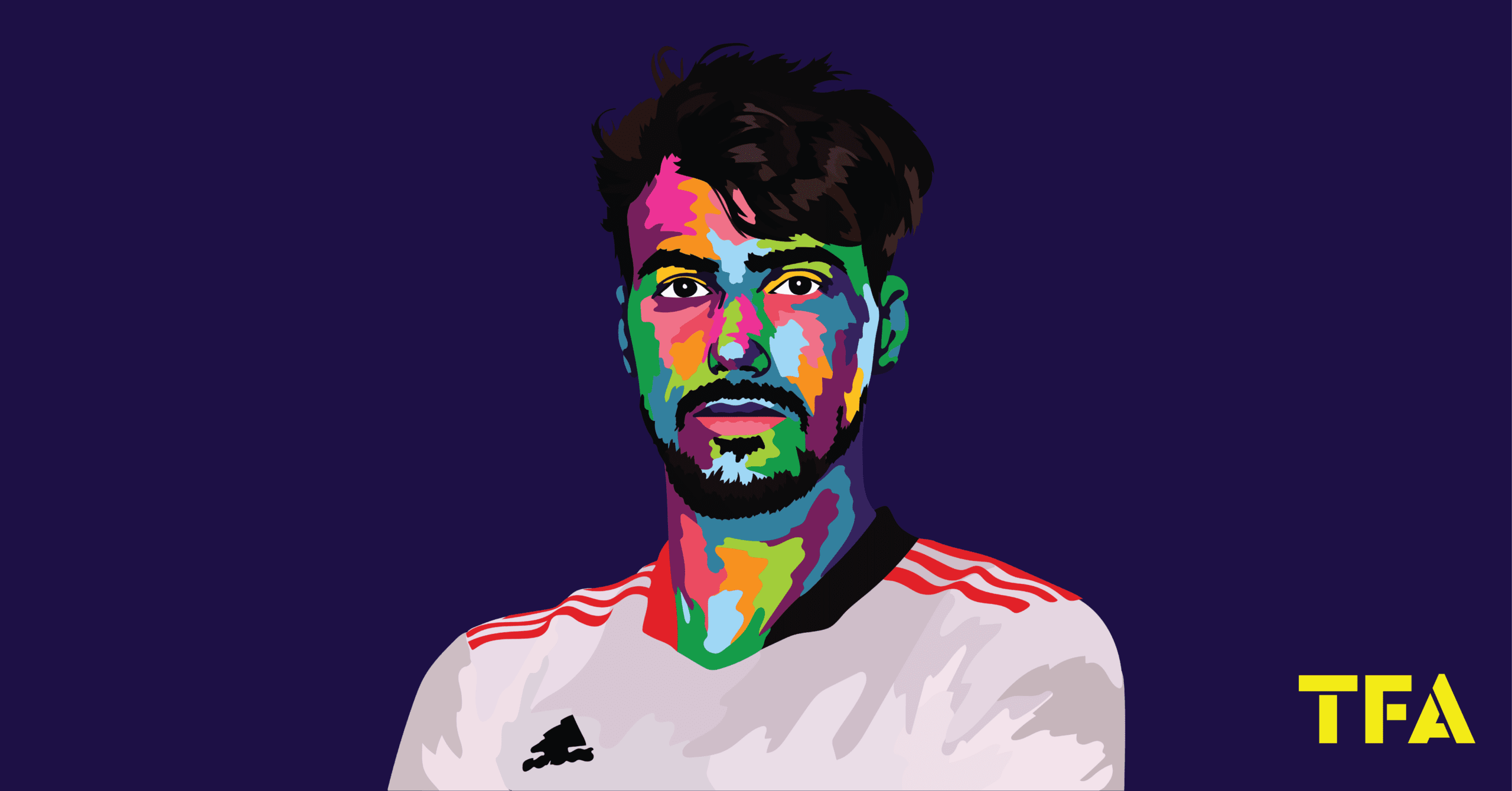




Comments